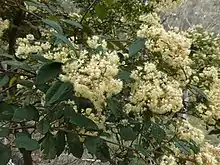| Pomaderris discolor | |
|---|---|
 | |
| At Black Mountain in the A.C.T. | |
| Scientific classification | |
| Kingdom: | Plantae |
| Clade: | Tracheophytes |
| Clade: | Angiosperms |
| Clade: | Eudicots |
| Clade: | Rosids |
| Order: | Rosales |
| Family: | Rhamnaceae |
| Genus: | Pomaderris |
| Species: | P. discolor |
| Binomial name | |
| Pomaderris discolor | |
| Synonyms[1] | |
|
Ceanothus discolor Vent. | |
Pomaderris discolor is a species of flowering plant in the family Rhamnaceae and is endemic to south-eastern continental Australia. It is a shrub with woolly-hairy stems, elliptic leaves, and clusters of pale yellowish flowers.
Description

Pomaderris discolor is a shrub that typically grows to a height of 1–3 m (3 ft 3 in – 9 ft 10 in), its stems covered with white, woolly, star-shaped hairs. The leaves are elliptic or egg-shaped, 30–95 mm (1.2–3.7 in) long and 10–40 mm (0.39–1.57 in) wide with stipules 4–6 mm (0.16–0.24 in) long at the base but that fall off as the leaf develops. The upper surface of the leaves is glabrous and the lower surface greyish and covered with star-shaped hairs. The flowers are pale yellowish and hairy, borne in pyramid-shaped panicles 30–60 mm (1.2–2.4 in) long on the ends of branchlets, each flower on a pedicel 1.2–2.5 mm (0.047–0.098 in) long. The floral cup is 0.5–11 mm (0.020–0.433 in) long, the sepals 1.2–1.7 mm (0.047–0.067 in) long and the petals 0.8–1.2 mm (0.031–0.047 in) long but fall off as the flower opens. Flowering occurs in September and October and the fruit is a hairy capsule.[2][3][4]
Taxonomy
This species was first formally described in 1804 by Étienne Pierre Ventenat who gave it the name Ceanothus discolor in his book Jardin de la Malmaison.[5] In 1808, Jean Louis Marie Poiret changed the name to Pomaderris discolor.[6]
Distribution and habitat
Pomaderris discolor grows in open forest and rainforest margins between the Crawford River in New South Wales and Sale in eastern Victoria.[2][3]
References
- 1 2 "Pomaderris discolor". Australian Plant Census. Retrieved 5 February 2022.
- 1 2 Harden, Gwen J. "Pomaderris discolor". Royal Botanic Garden Sydney. Retrieved 5 February 2022.
- 1 2 Walsh, Neville G. "Pomaderris discolor". Royal Botanic Gardens Victoria. Retrieved 5 February 2022.
- ↑ Wood, Betty. "Pomaderris discolor". Lucid keys. Retrieved 5 February 2022.
- ↑ "Ceanothus discolor". Australian Plant Name Index. Retrieved 5 February 2022.
- ↑ "Pomaderris discolor". Australian Plant Name Index. Retrieved 5 February 2022.